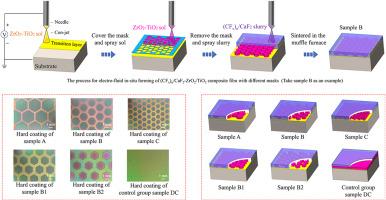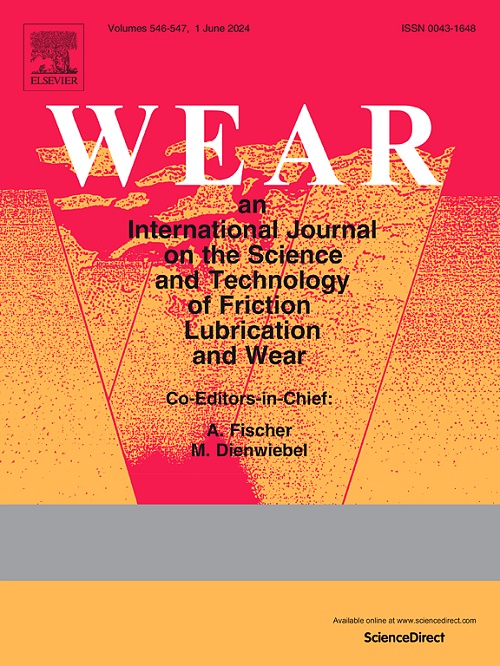电喷掩模原位形成 (CFx)n/CaF2-ZrO2/TiO2 复合薄膜的磨损性能
IF 5.3
1区 工程技术
Q1 ENGINEERING, MECHANICAL
引用次数: 0
摘要
本文采用电喷掩模原位成型技术制备了具有不同 ZrO2/TiO2 纹理分布的 (CFx)n/CaF2-ZrO2/TiO2 复合薄膜,以改善 (CFx)n/CaF2 润滑薄膜的粘附性能和摩擦学性能。研究了复合薄膜与 304 不锈钢对应物之间的微观结构、机械性能和往复磨损特性。结果表明,纹理硬膜显著提高了软膜的附着强度和复合膜的摩擦学性能。复合膜样品 B 的摩擦系数最低(∼0.100),薄膜磨损率较低(∼2.85 × 10-7 mm3 N-1 mm-1),在高温磨损过程中也表现出良好的自润滑性能。样品 C 的摩擦系数较低,为 ∼ 0.107,薄膜磨损率最低,为 ∼ 2.75 × 10-7 mm3 N-1 mm-1。与未进行纹理处理的复合薄膜样品 DC 相比,样品 B 的摩擦系数降低了 21.3%,而样品 C 的薄膜磨损率降低了 54.8%。这是因为硬膜的表面纹理处理增强了润滑剂颗粒的储存和流动,并在往复磨损过程中保持了稳定的自润滑膜。此外,(CFx)n 和 CaF2 在 25 °C-600 °C 的宽温度范围内具有协同效应。本文章由计算机程序翻译,如有差异,请以英文原文为准。

Wear performance of electro-jet mask in-situ forming (CFx)n/CaF2-ZrO2/TiO2 composite films
In this paper, the electrojet mask in-situ forming technology was used to prepare (CFx)n/CaF2-ZrO2/TiO2 composite films with different ZrO2/TiO2 texture distributions, to improve the adhesion properties and tribological performance of (CFx)n/CaF2 lubricant films. The microstructure, mechanical properties, and reciprocating wear characteristics between the composite films and 304 stainless steel counterparts were studied. The results showed that the textured hard film significantly improved the adhesion strength of the soft film and the tribological properties of the composite film. The composite film sample B had the lowest friction coefficient (∼0.100) and a lower film wear rate of ∼2.85 × 10−7 mm3 N−1 mm−1, and also showed good self-lubricating properties in the high-temperature wear process. Sample C had a lower friction coefficient of ∼0.107 and the lowest film wear rate of ∼2.75 × 10−7 mm3 N−1 mm−1. Compared with untextured composite film sample DC, sample B showed a 21.3 % reduction in friction coefficient, while sample C showed a 54.8 % decrease in film wear rate. This was because the surface texturing treatment of hard films enhanced the storage and flow of lubricant particles, and maintained a stable self-lubricating film during reciprocating wear. Moreover, (CFx)n and CaF2 have a synergistic effect in a wide temperature range of 25 °C–600 °C.
求助全文
通过发布文献求助,成功后即可免费获取论文全文。
去求助
来源期刊

Wear
工程技术-材料科学:综合
CiteScore
8.80
自引率
8.00%
发文量
280
审稿时长
47 days
期刊介绍:
Wear journal is dedicated to the advancement of basic and applied knowledge concerning the nature of wear of materials. Broadly, topics of interest range from development of fundamental understanding of the mechanisms of wear to innovative solutions to practical engineering problems. Authors of experimental studies are expected to comment on the repeatability of the data, and whenever possible, conduct multiple measurements under similar testing conditions. Further, Wear embraces the highest standards of professional ethics, and the detection of matching content, either in written or graphical form, from other publications by the current authors or by others, may result in rejection.
 求助内容:
求助内容: 应助结果提醒方式:
应助结果提醒方式:


